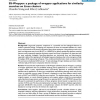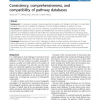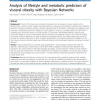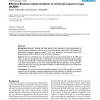311 search results - page 28 / 63 » Statistical significance in biological sequence analysis |
BMCBI
2004
13 years 7 months ago
2004
Background: Large-scale sequence comparison is a powerful tool for biological inference in modern molecular biology. Comparing new sequences to those in annotated databases is a u...
BMCBI
2010
13 years 7 months ago
2010
Background: It is necessary to analyze microarray experiments together with biological information to make better biological inferences. We investigate the adequacy of current bio...
BMCBI
2010
13 years 7 months ago
2010
Background: The aim of this study was to provide a framework for the analysis of visceral obesity and its determinants in women, where complex inter-relationships are observed amo...
BMCBI
2002
13 years 7 months ago
2002
Background: Recently, Almeida and Vinga offered a new approach for the representation of arbitrary discrete sequences, referred to as Universal Sequence Maps (USM), and discussed ...
CHI
2009
ACM
14 years 8 months ago
2009
ACM
We describe the use of a statistical technique called Tpattern analysis to derive and characterize the routineness of tasks. T-patterns provide significant advantages over traditi...




